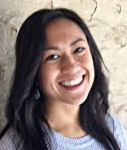Review: SOMEWHERE IN THE MIDDLE by Deborah Francisco (Philippines)
 Somewhere in the Middle: A journey to the Philippines in search of roots, belonging, and identity
Somewhere in the Middle: A journey to the Philippines in search of roots, belonging, and identity
Deborah Francisco Douglas (Philippines 2011–14)
Peaceful Mountain Press, 2019
254 pages
$14.99 (paperback); $8.99 (Kindle)
Reviewed by Janet Lee (Ethiopia 1974-76)
•
 Somewhere in the Middle, by Deborah Francisco Douglas, is a delightful memoir that captivated my interest from the first page.
Somewhere in the Middle, by Deborah Francisco Douglas, is a delightful memoir that captivated my interest from the first page.
Her use of dialogue, recreated from memories, journals, and blog posts, was an effective tool in telling her story. Vendors’ calls of “Balut” (dragged out as if a chant, “Baluuuuuuuut!”) or “Taho” (“Tahoooooooooo!”) reminded me so much of my short stays in the neighborhoods of metro-Manila. [Balut is a partially-developed duck embryo that is softboiled and considered a breakfast treat. Taho is a delicious custard drizzled with caramel syrup.]
She approximates the accents in the dialogues through the use of switching out “d” for the “th” sound, and “p” for “f” or “ph,” thus “How long do you stay in the Philippines?” becomes “How long you stay in da Philippines?” It is natural and not condescending. She also uses dialogue to illustrate the various ways that she was addressed. “Hey! Hey! Americana!” “De-BOR-ah!” “Ma’am Deborah.” “Ma’am Debs!” “Ate” (Sister). “Mestiza.” Who among us as Peace Corps Volunteers has not had some variation of our name or “foreigner” shouted out as we passed by? (How did those kids spot me from that distance?)
She points out the differences in culture and in day-to-day life in a humorous and endearing way, from chasing down a cockroach in the middle of the night with a flashlight to learning how to politely decline the incessant appeals for her to “eat, eat, eat.” From romantic overtures or matchmaking to blatant stares. “You want Pilipino boyfriend?” She takes cultural assimilation in stride as evidenced when her host family’s young son burst into her bathroom (CR/Comfort Room) on her first day, droped his jeans, and took a tinkle in her toilet as she was brushing her teeth. “Of course, the only logical thing to do in that situation was to start a conversation. So I did.”
Learning the local language is a high priority for all new volunteers in their initial training. Although the daughter of a Filipino father and “American” mother, she didn’t really have a familiarity or innate ability to speak the language upon arrival. “But your Pilipino, right? And you don’t speak Tagalog?” She soon learned that Filipinos covered up their embarrassment through laughter and a self-described “nosebleed”— something similar to a “brain freeze” in English. (My Filam [Filipino-American] son startled a couple of store clerks who were laughing in embarrassment one time when out of his mouth he stated that he had a nosebleed in Tagalog). Over her three years of total immersion, she did pick up the language, but resorted to English when the stakes were high.
Descriptions of travel to communities in northern Luzon brought back many memories for me: the areas of Baguio, Banue, Sagada, (I, too, have a hand-crafted Sagada bag), and the rice terraces. Her cement-block house in Baguio clung precariously to the side of a mountain. “Just as long as there are no landslides, you should be safe,” she was told. But the reader does not need to have traveled there to appreciate the beauty. She describes her living arrangement:
The view across the valley overlooked enormous mountains upon mountains fading into the distances, sometimes even with a glimpse of the ocean beyond. Clouds drifted through in thick, puffy formations, giving me the feeling of living above the world. Like an island in the sky, surrounded by a sea of clouds.
Central to this beautifully written memoir was the reconciliation of being an American of partial Filipino ancestry. Too often there is a misconception from host-country nationals that all Americans are blond-haired and blue-eyed, and she faced that stereotype on more than one occasion. Through time and reflection, she learned to recognize the duality, struggled with it, accepted it, and embraced it. The journey was not easy and like all struggles had its rewards and challenges.
As the close of service approached, she reflected,
I had a dream one night that I went back home after my service and, although I was surrounded by people, I felt lonely. Like I didn’t fit in. No one understood what I had been through or the changes I felt. Everyone went on with their lives, and I was left feeling lost and out of place. Was there a way to make my two worlds unite?
She and the reader are better for this introspection.
It is not necessary to have traveled to the Philippines or to be a Returned Peace Corps Volunteer to appreciate this beautifully crafted memoir. A love of travel, exploration, and appreciation of different cultures is all it takes.
•
Reviewed by Janet Lee (Ethiopia 1974-76). Janet served in Ethiopia during the last days of Emperor Haile Selassie and the first two years of the Derg, returning to Ethiopia six times for library and literacy endeavors. She has traveled to the Philippines several times with her researcher son, who like the author, is Filam.
No comments yet.
Add your comment